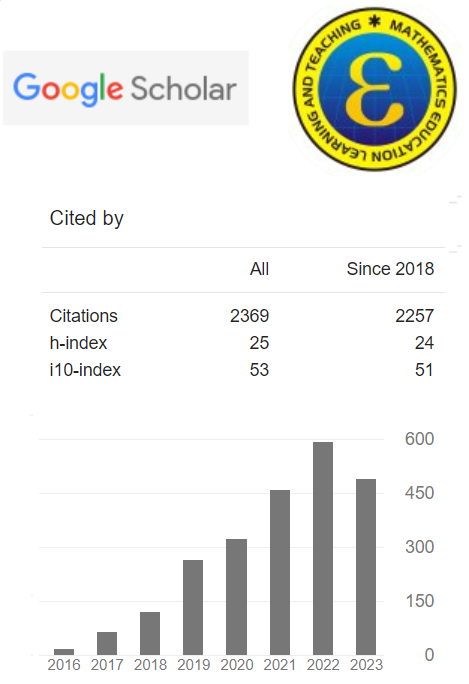Praxeological Analysis of Mathematics Textbooks for Class XI High School Students on Arithmetic and Geometric Sequences
(1) Universitas Pendidikan Indonesia
(2) Universitas Pendidikan Indonesia
(3) Universitas Pendidikan Indonesia
(*) Corresponding Author
Abstract
This study aims to analyze one of the mathematics textbooks published by the Ministry of Education and Culture. Then, the researcher will provide recommendations regarding the presentation of easy-to-understand material based on analysis of techniques, technology, and theory on each problem given by students' mathematics textbooks. This type of research is qualitative with a didactic anthropological theory approach, especially in praxeology. Data collection techniques in the library by reading, recording and processing these sources as research material. Researchers choose books based on the criteria needed to obtain relevant data. These criteria include (1) there is a problem in presenting mathematical material, (2) there is an author's name, and (3) publications from the Ministry of Education and Culture. The researcher found problems in the 2017 revised edition of class XI students' mathematics textbooks finding formulas and examples of arithmetic and geometric sequences. The study results showed several problems presenting the material for arithmetic and geometric sequences, which would raise student learning barriers. The identified Learning barriers are ontogenic, epistemological, and didactical obstacles. With these obstacles, the researcher provides alternative designs which are expected to minimize the occurrence of student learning barriers. So that the design alternatives provided can reduce obstacles for students in thinking and understanding the material of arithmetic and geometric sequences
Keywords
Full Text:
PDFReferences
Adolphus, T. (2011). Problems of Teaching and Learning of Geometry in Secondary Schools in Rivers State , Nigeria. International Journal of Emerging Sciences, 1(2), 143–152.
Bishop, J. P., Lisa, L. L., Randolph, A. P., Lan, W., Bonnie, P. S., & Melinda, L. L. (2014). Obstacles and affordances for integer reasoning: An analysis of children’s thinking and the history of mathematics. Journal for Research in Mathematics Education, 45(1), 19–61. https://doi.org/10.5951/jresematheduc.45.1.0019
Bosch, M., & Gascón, J. (2006). Twenty-five years of the didactic transposition. ICMI Bulletin, 58(58), 51–65.
Brousseau, G. (2002). Theory of Didactical Situations in Mathematics. In Theory of Didactical Situations in Mathematics (Volume 19). Kluwer Academic Publishers. https://doi.org/10.1007/0-306-47211-2
Cesaria, A., & Herman, T. (2019). Learning obstacle in geometry. Journal of Engineering Science and Technology, 14(3), 1271–1280.
Ekawati, R., Lin, F. L., & Yang, K. L. (2015). Developing an Instrument for Measuring Teachers’ Mathematics Content Knowledge on Ratio and Proportion: a Case of Indonesian Primary Teachers. International Journal of Science and Mathematics Education, 13(1), 1–24. https://doi.org/10.1007/s10763-014-9532-2
Fitriani, N., Kadarisma, G., & Amelia, R. (2020). Pengembangan Desain Didaktis Untuk Mengatasi Learning Obstacle Pada Materi Dimensi Tiga. AKSIOMA: Jurnal Program Studi Pendidikan Matematika, 9(2), 231. https://doi.org/10.24127/ajpm.v9i2.2686
Hartati, S. (2021). Analisis Kesulitan Siswa SMA dalam Memahami Materi Barisan dan Deret. Supermat . Jurnal Pendidikan Matematika, 5(2), 85–95. https://doi.org/10.33627/sm.v5i2.728
Hercovics, N. (1989). The Description and Analysis of Mathematical Processes. Center for Mathematics, Science, and Computer Education Rutgers.
Karim, R. S. A., & Novtiar, C. (2021). Analisis Kesulitan Siswa SMK Kelas X di Kota Bandung dalam Menyelesaikan Soal Materi Barisan dan Deret. Jurnal Pembelajaran Matematika Inovatif, 4(6), 1465–1472. https://doi.org/10.22460/jpmi.v4i6.1465-1472
Melfianora. (2019). Penulisan Karya Tulis Ilmiah dengan Studi Literatur. Open Science Framework, 1–3. osf.io/efmc2
Noto, M. S., Priatna, N., & Dahlan, J. A. (2019). Analysis of learning obstacles on transformation geometry. Journal of Physics: Conference Series, 1157(4), 0–5. https://doi.org/10.1088/1742-6596/1157/4/042100
Pirmanto, Y., Farid Anwar, M., & Bernard, M. (2020). Analisis Kesulitan Siswa SMA Dalam Menyelesaikan Soal Pemecahan Masalah pada Materi Barisan dan Deret dengan Langkah-langkah Menurut Polya. Jurnal Pembelajaran Matematika Inovatif, 3(4), 371–385. https://doi.org/10.22460/jpmi.v3i4.371-384
Putra, Z. (2017). Anthropological Theory of the Didactic : a New Research Anthropological Theory of the Didactic : a New Research Perspective on. Prosiding The Second International Conference on Education, Technology, and Sciences, June, 142–149.
Rahayu, T. G., Herman, T., & Prawiyogi, A. G. (2022). Teori dan Teknologi Materi Pecahan pada Buku Teks Matematika Sekolah Dasar. Mimbar Ilmu, 27(2), 321–332. https://doi.org/10.23887/mi.v27i2.45158
Rismawati, Y., Nurlitasari, L., Kadarisma, G., & Rohaeti, E. E. (2018). Analisis Karakteristik Learning Obstacle Siswa Smp Dalam Menyelesaikan Soal Bangun Datar. JPMI (Jurnal Pembelajaran Matematika Inovatif), 1(2), 99. https://doi.org/10.22460/jpmi.v1i2.p99-106
Rizqi, M. M., Wijayanti, D., & Basir, M. A. (2021). Analisis Buku Teks Matematika Materi Himpunan Menggunakan Model Prakseologi. Delta: Jurnal Ilmiah Pendidikan Matematika, 9(1), 57. https://doi.org/10.31941/delta.v9i1.1226
Sardiyanto, A. S., Pramesti, G., & Chrisnawati, H. E. (2017). Penerapan Model Problem Based Learning (PBL) Sebagai Strategi Untuk Meningkatkan Sikap Positif Dan Pemahaman Siswa Pada Materi SPLDV Di SMP N 1 Grogol Tahun Ajaran 2014/2015. Jurnal Pendidikan Matematika Dan Matematika (JPMM), 1(3), 71–81.
Sch, H. W., & Schultheis, F. (2020). Habitus Analysis 2 - Praxeology and Meaning. Springer VS.
Stone, R. (2022). Praxeology, Volume 1, Frame on self actualization for the modern man. Rian Stone.
Sumiaty, E., & Dedy, E. (2019). Didactical design work sheet of complex variable function based on epistemology, didactical, and learning trajectory to enhance student’s ability for representation and communication. Journal of Physics: Conference Series, 1280(4). https://doi.org/10.1088/1742-6596/1280/4/042033
Wijayanti, D., & Winslow, C. (2017). Mathematical practice in textbooks analysis: Praxeological reference models, the case of proportion. Journal of Research in Mathematics Education, 6(3), 307–330. https://doi.org/10.17583/redimat.2017.2078
DOI: 10.24235/eduma.v12i2.13289
Article Metrics
Abstract view : 0 timesPDF - 0 times
Refbacks
- There are currently no refbacks.
Copyright (c) 2023












